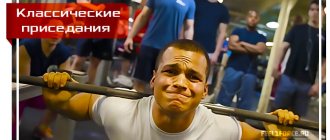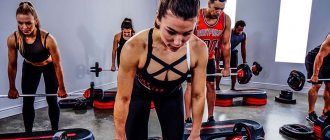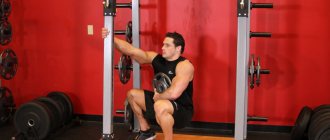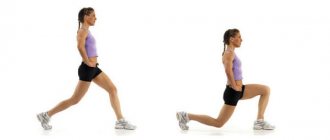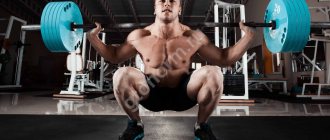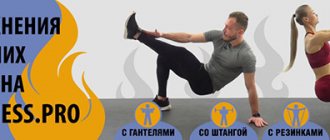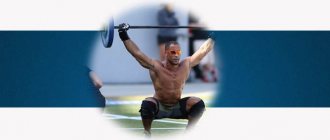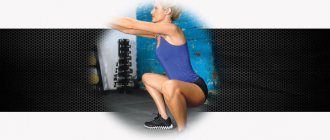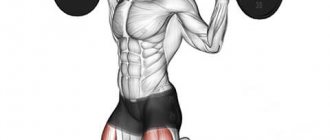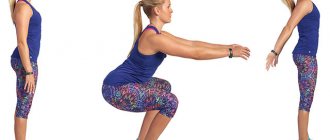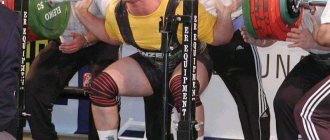Front squats are an exercise with a barbell on the chest, which is performed while maintaining a special body position. In the article we will look at the correct technique for performing it, and also tell you what mistakes beginners most often make.
Front squats with a barbell are the best exercise for training your legs. It allows you to quickly outline the muscles, form a beautiful relief, and achieve ideal proportions. It requires high energy expenditure, therefore, paired with a suitable diet, it perfectly promotes weight loss. If, on the contrary, your diet is aimed at increasing muscle mass, you will very quickly increase the volume of your thighs.
The exercise is recommended to be performed only by experienced athletes with a developed level of coordination, strong core muscles, and ligaments and joints accustomed to heavy weights. Beginners should first squat with an empty bar to thoroughly learn the technique.
Try starting to exercise in a Smith machine, in which the barbell is fixed and moves up and down only within a set path. Thus, the athlete does not need to control his balance, which makes it much easier to perform squats.
What are the advantages of front squats with a barbell, let's take a closer look at this point:
- Productively pumps up the muscles of the lower body and abs;
- Do not put extreme stress on the knee joints and spine;
- The technique is easy even for beginners. If they start moving incorrectly, there will be no harm to the body, since the barbell will simply fall out of their hands;
- Helps develop a sense of balance;
- Actively promote fat burning and muscle growth.
What muscles work during front squats with a barbell?
Front squats, like classic ones, are aimed at working the leg muscles:
- Quadriceps (medial, lateral, rectus and intermedius muscles);
- Biceps femoris;
- Gluteus maximus muscle.
When performing a front squat with a barbell, the load falls more on the upper part of the quadriceps , whereas with classic squats, the quadriceps is loaded more evenly.
This is due to a shift in the center of gravity due to the movement of the barbell from the back to the chest.
Some technical nuances
Athletes do not pay much attention to sports shoes and clothing, but when performing deadlifts, and especially squats, choosing the right shoes comes to the fore. Sports shoes should have a small heel (thin heel). Soft sneakers and flat soles are not an option for performing front squats.
To give the body additional stability, it is allowed to place two pancakes or a wooden block under the heel. This helps especially people with flat feet.
Clothing is also important, so pay attention to what you are wearing to avoid the bar slipping during front squats, and therefore injury. In order for the latter (the neck) to hold better, chalk (talc) is applied to the collar and chest area.
Features of the front squat
Front squats differ from classic ones in that the barbell is not placed behind the back on the shoulders and trapezius, but on the upper segment of the pectoral muscles and the front deltoids. The position of the hands is also different. With front squats, the hands are in front and hold the barbell, while being crossed at the forearms , and the elbows look forward.
There is
an alternative version of the position of the hands during a front squat: the hands support the barbell from below, and the elbows, as in the previous version, look forward. This method of holding a barbell is very similar to the weightlifting method (the position of the hands before performing a push of the barbell). However, this option is used extremely rarely.
How to increase the load
For those who have never had to practice a front squat before, it is better to increase the load not by weeks, but by months. You shouldn’t chase too much weight, as it will spoil the execution technique. This is especially true in the case of beginners.
If you approach the process of shaping your figure competently, then you should include regular squats in your training regimen, without focusing exclusively on front squats. These exercises need to be alternated. For example, when the maximum load is reached in a regular squat, it is worth changing it to a front squat and performing it for two to three months. Then return to the classics again.
Such alternations will allow you to fully load all the muscles of the legs and achieve new strength indicators much faster.
Advantages and Disadvantages of Front Squats
Performing front squats is technically more difficult than classic barbell squats. It is the difficulty of execution caused by the center of gravity shifted forward that makes the main disadvantage of front squats an increased risk of injury .
Some of the main benefits of this exercise include reducing stress on the lower back and lower back, as well as helping to develop explosive strength. Additionally, as mentioned earlier, the front squat helps target the upper quadriceps in more detail.
Equipment and contraindications
Performing front squats is impossible without special training. It is important to consider the following nuances:
- Stretching. The exercise is suitable for people who are in good physical shape. Particular attention should be paid to working out the muscles of the lower back and legs. Without this, it is almost impossible to maintain correct posture during training.
- Shoes. The ideal option would be to use special models for strength training - weightlifting bars. These sneakers are complemented by a small thick heel. The design of the products is created to increase the effectiveness of training and protect against injuries.
- Cloth. Barbell training requires a lot of physical effort. Experts do not recommend wearing things that absorb moisture. Preference should be given to tissues that can drain fluid from the body.
Beginners can only work with an empty bar. Additional weights are used after the technique has been perfected. You should not perform the exercise if you feel pain in the lower back; first you need to strengthen the muscles, then start strength training. If you experience discomfort in your knee joints when performing a squat, you can wrap them with an elastic bandage.
The frontal method of squats is contraindicated for people who suffer from diseases of the spine, ankle or knee joints. You cannot perform the exercise if you have varicose veins or problems with the cardiovascular system.
Performing front squats is impossible without special training.
Execution technique
The barbell squat, whether classic or frontal, is an exercise that places an increased axial load on the spine, so when performing it, it is especially important to pay attention to technique.
The correct technique for performing a front squat is:
- Take a standing position with your feet shoulder-width apart;
- Keep your back straight, slightly arched at the lower back;
- Place the barbell on the front deltoid muscles, securely fixing the barbell in this position with your arms crossed at the forearms;
- Elbows should face forward, parallel to the floor;
- Remove the bar from the racks, step back a little (1-2 steps);
- Having taken the starting position, make sure that your feet are shoulder-width apart and the barbell is securely fixed;
- As you inhale, perform a deep squat;
- Fix at the bottom point for 0.5-1 second;
- As you exhale, return to the starting position.
Note:
- The movement is performed slowly, smoothly, under control in both the negative and positive phases;
- The feet do not come off the floor;
- The gaze is directed in front of you, the head does not lower;
- The back remains flat, with a slight arch in the lower back.
Practical advice
The front squat is an exercise that can be performed without a barbell, although its use is a priority. It is replaced with dumbbells, which need to be taken with a regular grip, without crossing your arms. At the same time, you should straighten your shoulders a little wider. The palms should be directed upward and the elbows should not be spread to the sides.
It makes sense to perform this exercise in front of a mirror, it makes it easier to practice the squat technique. Moreover, special emphasis needs to be placed on it (the technique), since the result directly depends on the correct execution of the squat.
At the final stage of the exercise, during the upward jerk, you should not fully extend your knees in a standing position. This will take the stress off the hip and transfer it to the joints. Therefore, at the extreme point of lifting, you need to leave your knees slightly bent, maintaining the load on the muscles.
As for the number of repetitions, each person must calculate them individually. But if we talk about average standards, then you can start with 3 sets of 6-12 repetitions, depending on how you feel.
Front Squat Variations
Front squats can be performed not only with a barbell, but also with dumbbells or kettlebells, as well as in a Smith machine.
Option with dumbbells and kettlebells
The front squat with dumbbells or kettlebells is often used by beginners or girls, as these equipment are considered safer for use in this exercise.
With dumbbells
With weights
Read about how to do squats with dumbbells → About squats with a kettlebell in this article →
Variant in Smith's machine
Among the main advantages of the front squat in the Smith machine are safety, which in turn indicates a reduced risk of injury, as well as less load on the spine and knee joints, thanks to which the athlete can fully concentrate on working out the target muscle group. In addition, the Smith front squat helps you understand the technique of this exercise and then transfer it to working with free weights.
Perhaps the only serious drawback of front squats in the Smith machine is the lack of load on the stabilizer muscles. The Smith machine is designed in such a way that the bar moves along a given vertical path, and the athlete does not have to hold it in space. On the one hand, this is a plus, since you can completely focus on working out the target muscles, as mentioned earlier, but on the other hand, the stabilizer muscles also need to be given enough attention, so it is recommended to alternate work in the Smith machine and with free weights .
Variations
Depending on which muscles you want to pump with front squats, you can perform different variations. For example, if you take not a barbell, but other weights or position your legs differently, the load will be distributed differently than in a classic exercise.
- In Smith
Smith front squats are much easier to perform than the classic exercise. In addition, they guarantee greater safety for the back and knees. The barbell is placed on crossed arms. Elbows are parallel to the floor. Feet are placed at shoulder level, toes turned out at approximately 45°. Everything else is strictly classic.
- With dumbbells
Recommended for girls who most often have no need for muscle growth, but want to make their legs slimmer and their buttocks more attractive. And the weight is light, and the exercise is easy to perform. Simply take a dumbbell of the required weight in each hand, raise your arms to your shoulders and start squatting.
- With fingerboard
Another option for women is an exercise with a barbell that is not burdened with weights. Makes it easier to master the classical technique and does not cause as much muscle gain.
- With a weight
Front squats with kettlebells are recommended for experienced athletes who already know how to handle this equipment, that is, they can press it well from the shoulder a sufficient number of times. The result is not building muscle mass, but polishing the relief of the legs. One of the obvious advantages is that you can perform the exercise with the same weight an infinite number of times. If you do it with a weight (one), it should be located at the chest, if with two, they are held with your hands straightened at the shoulder joint. The correct technique of execution is that the projectile rests on the upper point of the biceps and the anterior delta.
- Wide / narrow
These exercises can be performed with a wide stance (the so-called “sumo”) or a narrow one. In the first case, the feet are placed far from each other, the toes are turned to the sides. This position allows you to hold larger weights than in the classic outcome. The inner thigh and buttocks are mainly trained. If your feet are placed together, the main load will shift to the quadriceps.
- Depending on the grip
As practice shows, the grip in front squats can be different. Firstly, you can hold the barbell by placing your hands in a cross on top of each other (overlapping) - this is a classic of the genre. Secondly, you can put your elbows forward and hold the barbell with a reverse grip. However, this position puts too much stress on the hands, and intense training can result in injury. Thirdly, weights and dumbbells are taken with a direct grip on the chest.
So front squats are different, and it’s up to you which ones will become the basis of training to pump up this or that muscle group.
Common mistakes and recommendations
Those who are just starting to use front squats in their training often make the same mistakes:
- They look not straight ahead, but up or down, which often leads to loss of balance;
- Hold your back unevenly;
- They reduce the amplitude of movement, most often not descending completely;
- They use too much weight, as a result of which the bar simply falls out of the hands.
Recommendations:
- Perform a front squat in front of a mirror or have someone watch your technique;
- Pay attention to the position of your legs and back, as well as the direction of your gaze;
- At the top point, leave your knees slightly bent, since their full extension removes the load from the leg muscles and transfers it to the knee joints, which can subsequently lead to injuries or diseases of the joints;
- Don't chase the scales. Front squats have a number of technical features, so you are unlikely to be able to immediately squat with the same weights as with the classic version of this exercise.
Front squats can take your leg training to the next level. They are especially relevant for those whose legs are a lagging muscle group, as well as for people who have recently recovered from back injuries, especially the lumbar region.
Errors allowed
Although it would seem that there cannot be a priori mistakes when performing front squats, they do happen:
- movements are performed too quickly, i.e. jerkily. This makes it difficult to fully use the leg muscles, i.e. reduces the productivity of front squats;
- blocking the knees, i.e. in a standing position, their full extension. This relieves tension from the quadriceps, but increases the load on the joints;
- deviation of the back and head from a straight line leads to a fall of the projectile or a tilt of the body;
- incomplete use of the amplitude slows down the growth of muscle fibers due to their incomplete use;
- the execution technique is disrupted when using excessive weight;
- You need to hold the projectile with the strength of your wrists and hands.
Interesting Facts
This exercise is mainly used by weightlifters. The push of the barbell requires a squat when jerking it to the chest, since without it such large weights simply cannot be conquered.
The phase in which, after squatting, the athlete rises to a straight position for the subsequent push, is an analogue of the front squat. And so that there are no problems with it, these squats are worked out as a separate exercise.
And this is far from the only example of a movement that representatives of other strength sports can borrow from weightlifters.
It is worth noting that tall people find it easier to do front squats than classic ones.
